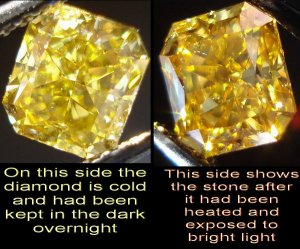- Joined
- May 27, 2009
- Messages
- 13
I am a semi-educated newby interested in color-changing diamonds. Now, my understanding has been that in diamonds - under "normal" lighting conditions that won''t kill you or your retina - this effect is limited to chameleons, which change color based on (a) temperature; or (b) light exposure. In particular, with light exposure the diamond displays a different color after being kept in the dark for a while, but quickly reverts back to the main color when exposed to light again. In my (limited) understanding, these were the only color change mechanisms in diamonds. (Some could also display a different color under UV, but that''s not "normal" lighting.)
However, recently a friend of mine - who has a degree in some "geological" (not "gemological") science - has insisted that there also are diamonds that display an Alexandrite-like effect. That is they can display a vivid change of color (e.g. same clear "green" "yellow" transition as chameleons), but in a light-dependent manner and _without_ reverting to main color after exposure (i.e. green in day-light; yellow under incandescent - with coloration display lasting indefinitely as long as the light source does not change). My friend claims to have seen a couple of such stones, but I''ve never even heard of something like this - either from people interested in diamonds OR in alexandrite (and they ought to know as they are constantly pre-occupied with possible alexandrite "substitutes"
 )... Is this really possible??? (And, if so, what is the mechanism and how frequent/rare such stones are? What are the color pairs seen?)
)... Is this really possible??? (And, if so, what is the mechanism and how frequent/rare such stones are? What are the color pairs seen?)
Thanks for the help!
dy
However, recently a friend of mine - who has a degree in some "geological" (not "gemological") science - has insisted that there also are diamonds that display an Alexandrite-like effect. That is they can display a vivid change of color (e.g. same clear "green" "yellow" transition as chameleons), but in a light-dependent manner and _without_ reverting to main color after exposure (i.e. green in day-light; yellow under incandescent - with coloration display lasting indefinitely as long as the light source does not change). My friend claims to have seen a couple of such stones, but I''ve never even heard of something like this - either from people interested in diamonds OR in alexandrite (and they ought to know as they are constantly pre-occupied with possible alexandrite "substitutes"

Thanks for the help!
dy









300x240.png)